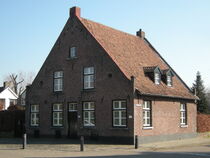| Schinderhinke | |
|---|---|

| |
| The Gelderse Postwagen, reconstructed in the 20th century after it was burned down in 1753. | |
| Also Known As | Hölster Heinkem, Hulstehinke, Schinderhannes |
| Province | Limburg |
| City | Venlo
|
Schinderhinke (also known as Hulstehinke Schinderhannes or Hölster Heinke) was a Gloeiige who roamed the Maagdenberg in the region of Venlo in Limburg, close to what is now the German border. In his waking life around the year 1750[1] he was the head of what was arguably the most notorious gang of bandits from the area. Locals claimed his spirit still wanders the Maagdenberg and out of fear people from the area periodically left him tin shoes, 7 and a half in cash and a pile of sand to help extinguish the ever-burning flames within him. Those who had seen him from afar, described the gloeiige as a big lantern surrounded by fireflies. Up close he looked more like a dark figure, wearing a big wide-rimmed hat with a beard that would spark up whenever he opened his mouth.
Bandit Schinderhinke[]
Prior to his bandit activities, Schinderhinke rebelled against the recruitors sent by king Willem I of Prussia. These recruitors were known to pull young men from their beds for them to start serving in the army. Hinke actually received a lot of praise and admiration from the locals for these courageous endeavors. It didn't take long for the people to start fearing him however. Hinke was well acquainted with gypsies from the area as he was married to one and often found himself new recruits. After robbing their victims they were held captive for ransom. Their untimely death was often due to a lack of compliance, as the bandits would then throw their victims to drown in the Maas (Muese river) with a heavy stone attached to their neck. After burning down a local inn and postal office on October 8 in 1753, Schinderhinke was put on notice by authorities. Hinke was eventually shot and went into hiding. The Hulsterhof farmer betrayed him as it never sat well how Hinke had once killed one of his maids by drowning her in a butter churn for fun. Eight other bandits including Schinderhinke's wife were hung whereas Schinderhinke died bound to a breaking wheel on top of the Maagdenberg.
Hinke's Name[]
Hinke's real name was Heinrich van de Rooth, born in the German town of Kaldenkirchen. Tales say Hinke's father was a horse skinner from the same town just over the border, which is how "schinder" was derived from his father's profession. Alternatively Hinke was known as "Hulsterhinke" which derived itself from Hulsterhof, the name of his head quarters. Some speculate that "Hinke" may have been bastardized from the German word "heinke" which was an alternative name for "executioner".[2]
A Story From The Maagdenberg[]
The Maagdenberg used to know 2 sawmills. One was at the top and the other was down the hill. A servant from the upper mill once rode a cart full of cargo down to the city of Venlo. After his ascent, he looked back to the hill and saw on top of it a dark figure whose mouth looked to be on fire. Being a relative stranger to these parts, he knew Schinderhinke only from hearsay and in his ignorance he mentioned the forbidden words "Hé, Hinke, geef eens wat vuur!" As soon as he finished these words, the figure bolted down the hill in a flaming rage. His horse panicked and ran as fast as it could to escape the sparking bolt of fire behind them. The servant and his horse made their escape to the bottom sawmill where they managed to close the barn doors in the nick of time. When Schinderhinke caught up, he found himself locked out and agressively pounded on the door. The next morning the servant found the barndoors were charred with the mark of a black hand. This was a signature brand of the bandit gang Schinderhinke he used to lead in his waking life.[3]
References[]
- ↑ https://nl.wikipedia.org/wiki/H%C3%B6lster_Heinke
- ↑ http://www.citadelvenlo.org/bekende-venlonaren/hulster-heinke.htm
- ↑ Jacques R.W. Sinninghe: Nederlands Sagenboek